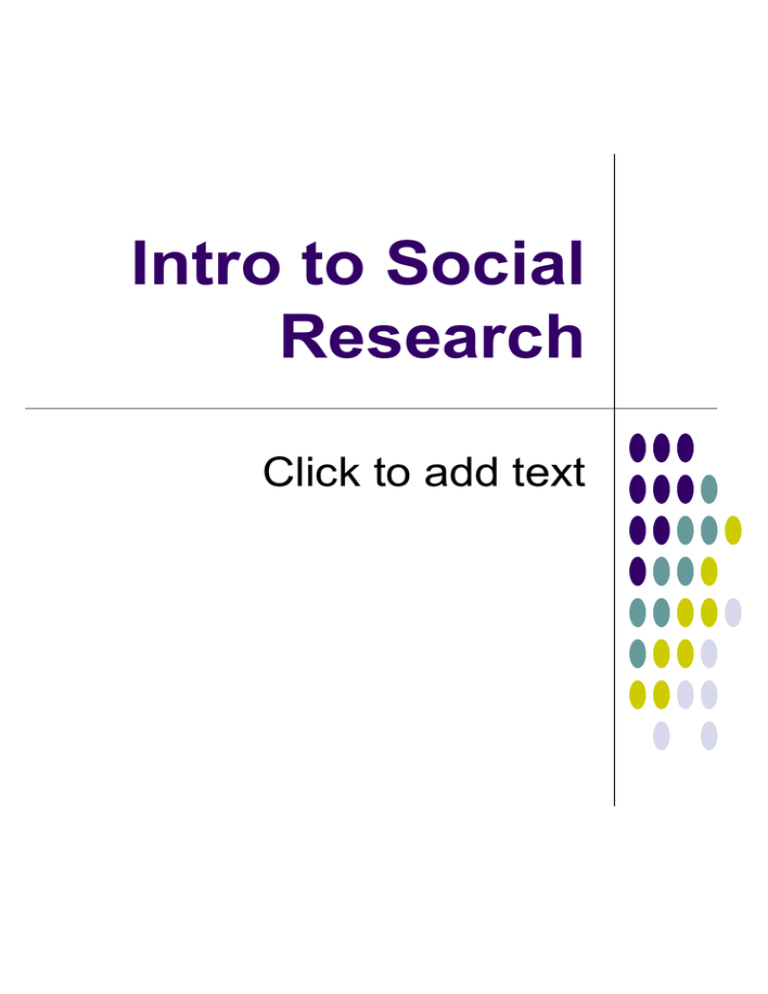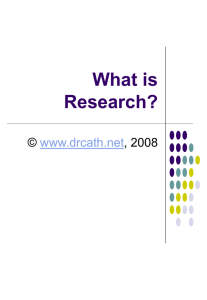Intro to Social Research Click to add text
advertisement

Intro to Social Research Click to add text Components of Research Theory Method Epistemology Ontological Considerations Objectivism Phenomena independent of social actors. Organisations and culture are said to exist as a tangible object, external to the social actor. Constructionism Social phenomena and their meanings are continually being accomplished by social actors. Not only produced through social interaction but they are in a constant state of revision. Research Design This involves: Defining the problem/research question Review of related literature Planning the research • • • What methodology will you use? What data do you want to use/produce? How feasible is your research approach? Ethical considerations. What do you need to think about when Designing Research? What is the purpose of the research? What are your units of analysis? What are your points of focus? What is the time dimension? Designing a research project: conceptualisation operationalisation. Reliability, replication and validity. Different Purposes of Research (1) Exploratory Goal is to generate many ideas. Develop tentative theories and conjectures. Become familiar with the basic facts, people and concerns involved. Formulate questions and refine issues for future research. It is the initial research. Usually qualitative research. Different Purposes of Research (2) Descriptive research Presents a profile of a group or describes a process, mechanism or relationship or presents basic background information or a context. Used very often in applied research. E.g.: General Household survey – describes demographic characteristics, economic factors and social trends. Can be used to monitor changes in family structure and household composition. Can also be used to gain an insight into the changing social and economic circumstances of population groups. Often survey research. Different Purposes of Research (3) Analytical (or explanatory) goes beyond simple description to model empirically the social phenomena under investigation. It involves theory testing or elaboration of a theory. Used mostly in basic research. Units of Analysis Can be • individuals, • groups, • organizations, • social artifacts • (ie. products of social beings, for example, books, poems, paintings, automobiles, buildings, songs, pottery, jokes and scientific discoveries). • behaviours (eg: social interactions, such as friendship choices, court cases, traffic accidents. Weddings (as a unit of analysis) – might be characterised as being religious or secular or ethnically or religiously mixed resulting in divorce or not or they could characterised by descriptions of one or both of the marriage partners. Points of Focus 1. 2. 3. 4. Characteristics Orientations (attitudes, beliefs, prejudices, personality traits) Organizations (would be in terms of policy, procedures etc Social interactions, actions. Considerations Time dimension – cross-sectional or longitudinal Conceptualisation – i.e. you must specify the meanings of the concepts and variables to be studied. Operationalisation – how will we actually measure the variables under study? Reliability – are the results repeatable? – relevant to quantitative social research. Replication - can others replicate the results? Validity – will examine later but are the results a true reflection of the world? Steps in Research Design 1. Choose a Topic. 1. Focus research question. 1. Design the study. 1. Collect the data. 1. Analyse the data. 1. Interpret the data. 1. Present the results. Research Proposal Title Statement of research question Remember to stress why the problem is important! Background/information Aims and objectives of the study Methods Timetable Data analysis Ethical issues In Funding applications, add Resources/Budget Dissemination Qualitative Research Methods I. Survey Questionnaires A. When to use? When goal is to get a broad perspective over a larger number of people Typically you ask more closed ended questions. Have a sample size of over 20-30 at least. B. Method of analysis Statistical. You present basic summaries of the types of responses you got. You interpret the meaning of these responses and your rational based on the data and previous research. Qualitative: Narrative methods II. Case Study Interviews A. When to use? When the goal is to go into depth about the meaning which individuals give to particular subjects and extract patterns of responses. Typically more open ended questions. Sample size is smaller (1-5?) Focus on individual(s) as means to speak about broader social relations. B. Method of analysis Case report Descriptive Analysis. You look at specific responses and extrapolate. Qualitative methods III. Discourse Interviews A. When to use? When the goal is to go into depth about the way in which social realities are produced and constructed. Open ended questions. Less structured, you follow a line of interest. Sample size is smaller (5-15?) Focus on how discourses and social context informs us about broader social relations. B. Method of analysis Contextual/historical overview Discursive analysis: you analyze transcripts of interviews and extrapolate patterns and their meaning in context. Examples of Discursive Analysis Margaret Weatherall. Interviewed New Zealanders and analyzed how their 'normal' discourses were reproducing racist social relations. Michael Billig. Banal Nationalism. Analyzed representative media and interviews in the USA to look at how those who don't identify as being nationalistic can often be the most nationalistic. Erica Burman. Child Development Discourses. She analyzed typical representations of children in developmental texts and looked at the patterns of how children are represented. Ethical Issues Informed Consent. Respect for privacy. Confidentiality and anonymity of data. What is permissible to ask? No harm to researchers or subjects. No deceit or lying in the course of research. Consequences of publication. www.the-sra.org.uk www.britsoc.org.uk/about/ ethics.htm Research Design Exercise Draft an outline proposal on one of the following: Single motherhood Teenage sexuality Discuss the outline proposal with the following in mind: • • • • How would you clarify the reasons for planning the study? What does the study aim to achieve? How will it be done? Will the findings be useful?



